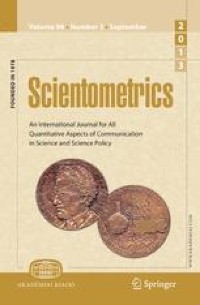How Easy Is It to Fudge Your Scientific Rank? Meet Larry, the World’s Most Cited Cat
How Easy Is It to Fudge Your Scientific Rank? Meet Larry, the World’s Most Cited Cat
“Exercise in absurdity” reveals flaws in Google Scholar’s productivity metrics
Send us a link
“Exercise in absurdity” reveals flaws in Google Scholar’s productivity metrics

The role of bibliometrics, such as impact factors and h-indices, in shaping research has been well documented. However, what function do these measures have beyond the institutional contexts in which, for better or worse, they were designed?

Article Attention Scores for papers don't seem to add up, leading one to question whether Altmetric data are valid, reliable, and reproducible.

In this study, a novelty indicator to quantify the degree of citation similarity between a focal paper and a pre-existing same-domain paper from various fields in the natural sciences is applied by proposing a new way of identifying papers that fall into the same domain of focal papers using bibliometric data only.

Women's contributions to the medical field have increased substantially over the past 4 decades but women remain underrepresented. Since research productivity is an important criterion for promotion, it was essential to assess the gender differences within the faculty of medicine and across departments. We conducted a bibliometric analysis using the Scopus database between 2009 and 2018 at the American University of Beirut (N = 324, 93 women, 231 men). Women comprised 29% of the faculty. The rank of Professor was held by 34% of men and 18% of women (p < 0.0001). Mean number of publications was 30.12 for males compared to 20.77 for females (p = 0.007). Men were more often last authors (p < 0.0001) and corresponding authors (p < 0.01). In the MD subcategory (N = 282), the gender difference in number of publications, H-index, and total citations was not significant. Women MDs were underrepresented as last authors (p < 0.0001). Among PhD faculty (N = 42), males had greater H-Indices (p = 0.02) and were more often last and corresponding authors. After adjusting for the year of appointment: the gender differences in corresponding and last authorship lost statistical significance among MDs but not among PhDs where it became more pronounced. In conclusion, women in the faculty of medicine were underrepresented in most departments, senior ranks and senior research authorships; H-indices generally did not differ, which was partially explained by the later year of appointment among females. In a developing country, greater family responsibilities especially early in their careers, may put women at a disadvantage in research productivity.

Big data bibliometrics must take into account qualitative analyses of research as a social institution, rooted in history, economics and politics.
